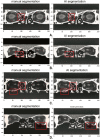Automatic Identification and Segmentation of Orbital Blowout Fractures Based on Artificial Intelligence
- PMID: 37022710
- PMCID: PMC10082383
- DOI: 10.1167/tvst.12.4.7
Automatic Identification and Segmentation of Orbital Blowout Fractures Based on Artificial Intelligence
Abstract
Purpose: The incidence of orbital blowout fractures (OBFs) is gradually increasing due to traffic accidents, sports injuries, and ocular trauma. Orbital computed tomography (CT) is crucial for accurate clinical diagnosis. In this study, we built an artificial intelligence (AI) system based on two available deep learning networks (DenseNet-169 and UNet) for fracture identification, fracture side distinguishment, and fracture area segmentation.
Methods: We established a database of orbital CT images and manually annotated the fracture areas. DenseNet-169 was trained and evaluated on the identification of CT images with OBFs. We also trained and evaluated DenseNet-169 and UNet for fracture side distinguishment and fracture area segmentation. We used cross-validation to evaluate the performance of the AI algorithm after training.
Results: For fracture identification, DenseNet-169 achieved an area under the receiver operating characteristic curve (AUC) of 0.9920 ± 0.0021, with an accuracy, sensitivity, and specificity of 0.9693 ± 0.0028, 0.9717 ± 0.0143, and 0.9596 ± 0.0330, respectively. DenseNet-169 realized the distinguishment of the fracture side with accuracy, sensitivity, specificity, and AUC of 0.9859 ± 0.0059, 0.9743 ± 0.0101, 0.9980 ± 0.0041, and 0.9923 ± 0.0008, respectively. The intersection over union (IoU) and Dice coefficient of UNet for fracture area segmentation were 0.8180 ± 0.0093 and 0.8849 ± 0.0090, respectively, showing a high agreement with manual segmentation.
Conclusions: The trained AI system could realize the automatic identification and segmentation of OBFs, which might be a new tool for smart diagnoses and improved efficiencies of three-dimensional (3D) printing-assisted surgical repair of OBFs.
Translational relevance: Our AI system, based on two available deep learning network models, could help in precise diagnoses and accurate surgical repairs.
Conflict of interest statement
Disclosure:
Figures






Similar articles
-
Layered deep learning for automatic mandibular segmentation in cone-beam computed tomography.J Dent. 2021 Nov;114:103786. doi: 10.1016/j.jdent.2021.103786. Epub 2021 Aug 20. J Dent. 2021. PMID: 34425172
-
Clinical validation of artificial intelligence-based preoperative virtual reduction for Neer 3- or 4-part proximal humerus fractures.BMC Musculoskelet Disord. 2024 Aug 27;25(1):669. doi: 10.1186/s12891-024-07798-z. BMC Musculoskelet Disord. 2024. PMID: 39192203 Free PMC article.
-
Development and validation of a deep learning-based framework for automated lung CT segmentation and acute respiratory distress syndrome prediction: a multicenter cohort study.EClinicalMedicine. 2024 Jul 26;75:102772. doi: 10.1016/j.eclinm.2024.102772. eCollection 2024 Sep. EClinicalMedicine. 2024. PMID: 39170939 Free PMC article.
-
Evaluating the Accuracy and Reliability of Blowout Fracture Area Measurement Methods: A Review and the Potential Role of Artificial Intelligence.J Craniofac Surg. 2023 Sep 1;34(6):1834-1836. doi: 10.1097/SCS.0000000000009486. Epub 2023 Jun 16. J Craniofac Surg. 2023. PMID: 37322582
-
Artificial intelligence and machine learning on diagnosis and classification of hip fracture: systematic review.J Orthop Surg Res. 2022 Dec 1;17(1):520. doi: 10.1186/s13018-022-03408-7. J Orthop Surg Res. 2022. PMID: 36456982 Free PMC article.
Cited by
-
Assessing the accuracy of artificial intelligence in the diagnosis and management of orbital fractures: Is this the future of surgical decision-making?JPRAS Open. 2024 Sep 30;42:275-283. doi: 10.1016/j.jpra.2024.09.014. eCollection 2024 Dec. JPRAS Open. 2024. PMID: 39498287 Free PMC article.
-
In Vivo Confocal Microscopy for Automated Detection of Meibomian Gland Dysfunction: A Study Based on Deep Convolutional Neural Networks.J Imaging Inform Med. 2025 Jan 27. doi: 10.1007/s10278-024-01174-y. Online ahead of print. J Imaging Inform Med. 2025. PMID: 39871043
-
Diagnostic performance of neural network algorithms in skull fracture detection on CT scans: a systematic review and meta-analysis.Emerg Radiol. 2025 Feb;32(1):97-111. doi: 10.1007/s10140-024-02300-7. Epub 2024 Dec 16. Emerg Radiol. 2025. PMID: 39680295
References
-
- Valencia MR, Miyazaki H, Ito M, Nishimura K, Kakizaki H, Takahashi Y.. Radiological findings of orbital blowout fractures: A review. Orbit. 2021; 40(2): 98–109. - PubMed
-
- Brucoli M, Arcuri F, Cavenaghi R, Benech A.. Analysis of complications after surgical repair of orbital fractures. J Craniofac Surg. 2011; 22(4): 1387–1390. - PubMed
-
- Ploder O, Klug C, Voracek M, Burggasser G, Czerny C.. Evaluation of the computer-based area and volume measurement from coronal computed tomography scans in isolated blowout fractures of the orbital floor. J Oral Maxillofac Surg. 2002; 60(11): 1267–1272; discussion 1273-1274. - PubMed
-
- Harris GJ. Orbital blow-out fractures: Surgical timing and technique. Eye (Lond). 200620(10): 1207–1212. - PubMed
Publication types
MeSH terms
LinkOut - more resources
Full Text Sources

